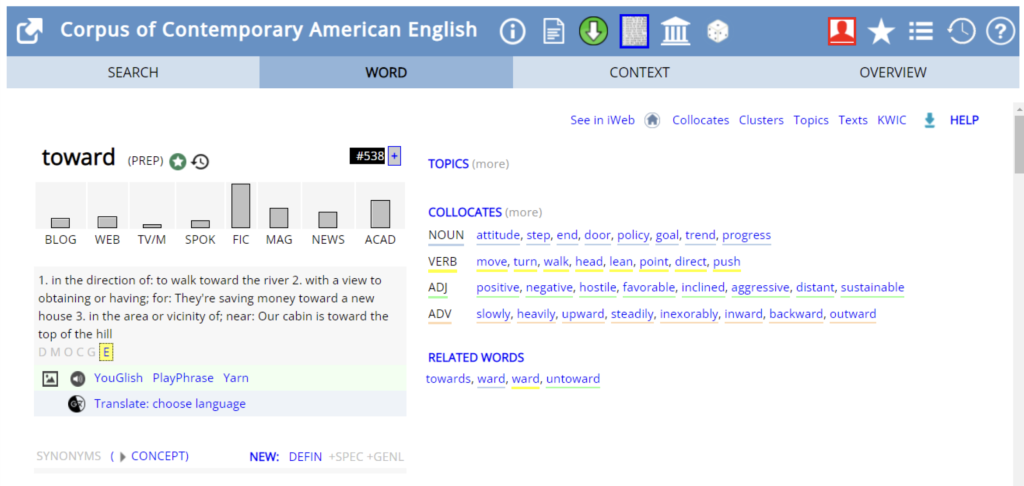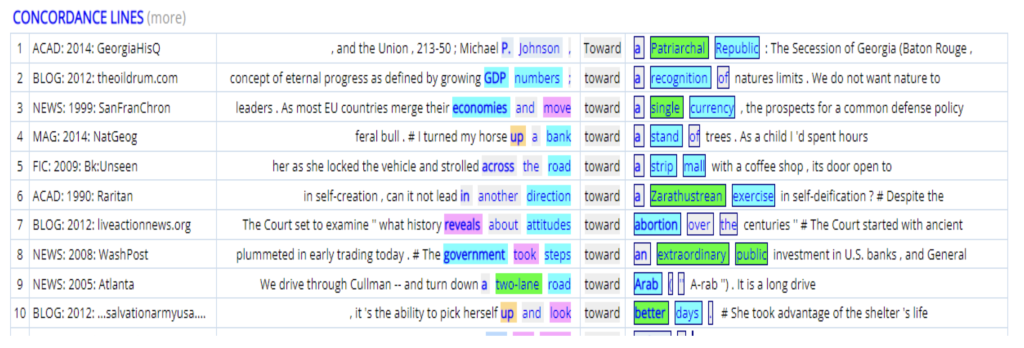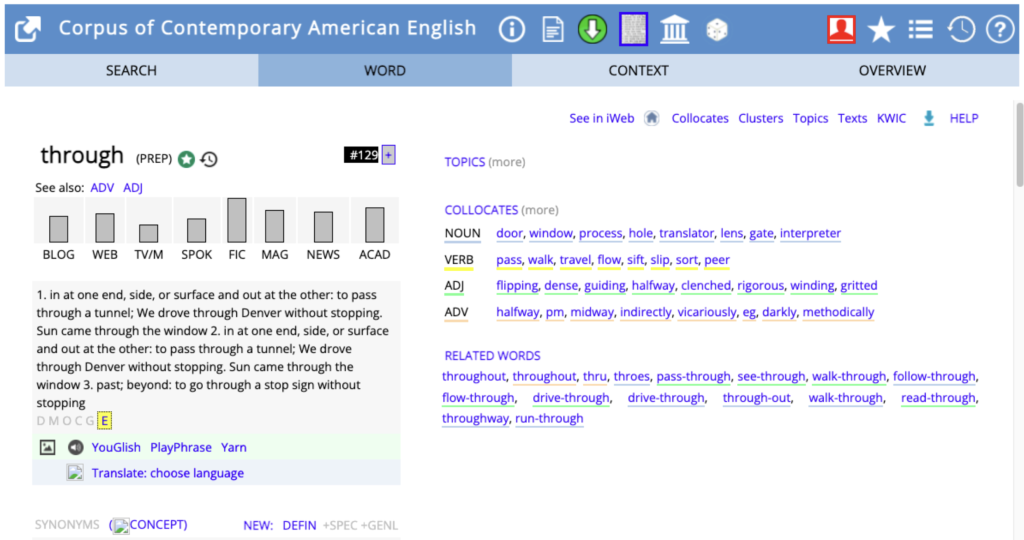4. Using COCA to explore the differences between ‘through’ and ‘toward’
Bruna Andrade; Gabriela Britto; Rita De Leeuw; and Raquel Silva
Bruna Andrade
Undergraduate student at Federal University of Rio Grande do Sul
Gabriela Britto
Undergraduate student at Federal University of Rio Grande do Sul
Rita De Leeuw
Undergraduate student at Montclair State University
Raquel Silva
Undergraduate student at Federal University of Rio Grande do Sul
Goals: To clarify the differences in use between the prepositions “through” and “toward”.
Audience: Intermediate to advanced learners of English (Secondary school students to adults)
Duration: 30-40 minutes
INTRODUCTION
The topic of prepositions is of particular interest to learners of English. In this chapter, we will focus on the prepositions of movement “through” and “toward”. This task analyzes their grammatical functions as taught by a grammar book, as well as how they actually work in a corpus. We also propose some exercises with these two prepositions using concordance lines from the COCA corpus.
STEP 1: CORPUS ANALYSIS
In the first phase of the class, we propose that the teacher uses the function word from the Corpus of Contemporary American English (COCA). The output of this function allows us to visualize how frequent these two prepositions are in the corpus, their collocates, clusters, and how they work in the contexts that they appear (concordance lines). The following two images depict the output for “toward” and “through”
TOWARD:

Figure 1 – COCA Word feature results for “toward” – Collocates
In Figure 1, it can be observed that the most common noun that appears together with “toward” is “attitude”, “step” and “end”. The most common verbs that appear with “toward” are “move”, “turn” and “walk”.

Figure 2 – COCA Word feature results for “toward” – Clusters

Figure 3 – COCA Concordance feature results for “toward”
Figures 2 and 3 provide more information regarding the use and frequency of toward, showing the context where this word appears. Using the function Charts in COCA, we can also see that the frequency of use of the word “toward” is higher in Fiction than in TV/Movies.
Before following the same steps with through, the teacher should highlight the following findings with students: “toward” appears more frequently in web and blog texts, mostly on articles and news texts. Furthermore, it is usually preceded by nouns or verbs and followed by pronouns or articles.
THROUGH:

Figure 4 – COCA Word feature results for “through” – Collocates

Figure 5 – COCA Word feature results for “through” – Clusters

Figure 6 – COCA Concordance Lines feature results for “through”
According to the data presented in figures 4-6, through primarily appears in the context of fiction. It is used to describe some plot situations, as it is very customary to give the reader a comprehensive description of the characters’ movements and circumstances. In those contexts, this preposition is quite essential when the author needs to describe an action scene and may combine it with verbs like “run”, “come”, “race”, “pass”, “step”, “walk”, “drive”, and so on.
In addition to fictional works, academic papers also show a relevant frequency in which through appears, mostly in education and humanities sections, but under different circumstances from the early examples. Highlighting the concordance lines, the teacher can show that the collocates of through are more varied than toward. This particular use differs significantly from how toward is used.
Below are some concordance lines that exemplify how these prepositions are used:
Through
- You must turn on your lights when passing through the tunnel.
- She walks through the park on her way to work.
Toward
- Who is that woman running toward us?
- Walk toward the sea and turn left at the first street.
STEP 2: PRACTICE ACTIVITIES
We hope that, in the first phase of class, the teacher explores both words in COCA following the tutorial above with the students. Then, we prepared a couple of exercises using the concordance lines from COCA, to help students practice the use of these two words.
Task #1:
While the prepositions “through” and “toward” have different semantic meanings, they often behave similarly in a sentence. For each of the following sentences, fill in the blank with the grammatically correct word: “through” or “toward.”
1) Knife blades should be turned _______ the plate. (WEB)
2) You walk _______ that door, you’re not coming back. (BLOG)
3) She sat there with her back _______ him. (WEB)
4) Gardner has been working _______ this goal for most of her life. (BLOG)
5) Government loans and grants helped me _______ school. (BLOG)
6) Mbasi turned and looked _______ the captain. (FIC)
7) I’m so glad you all made it _______ that awful storm. (BLOG)
8) Margo pointed _______ a couple of low hills behind us. (FIC)
9) The sun came _______ the leaves and there was a little breeze stirring. (FIC)
10) I’ve had a lot of interns pass _________ my office. (BLOG)
Task #2:
Two of the sentences below are grammatically correct. Identify the wrong sentences and rewrite them with the proper use of the prepositions “toward” and “through”.
1) I used to run away toward my window when I was a teenager to go to a party.
______________________________________________________________________
2) Brian wove his way through the crowd to talk to his father.
______________________________________________________________________
3) Eva suddenly turned and gesticulated through me, explaining how she got there.
______________________________________________________________________
4) Simon made a move towards her until they were face to face.
______________________________________________________________________
Task #3:
While the prepositions “through” and “toward” have different semantic meanings, they often behave similarly in a sentence. Both prepositions commonly appear immediately after the words “go,” “way,” “it,” and “down.” For each of these, write a sentence where the italicized word immediately precedes “through” and one where it immediately precedes “toward” to demonstrate the difference in meaning.
Example: “ran”
I ran through some scenic parts of our fair city. (BLOG)
We ran toward each other. (NEWS)
Andrade, B., Britto, G., De Leeuw, R., & Silva, R. (2023). Using COCA to explore the differences between ‘through’ and ‘toward’. In L. Goulart & I. Veloso (Eds). Corpora in English Language Teaching: Classroom Activities for Teachers New to Corpus Linguistics. Open Educational Resource. Montclair State University.
